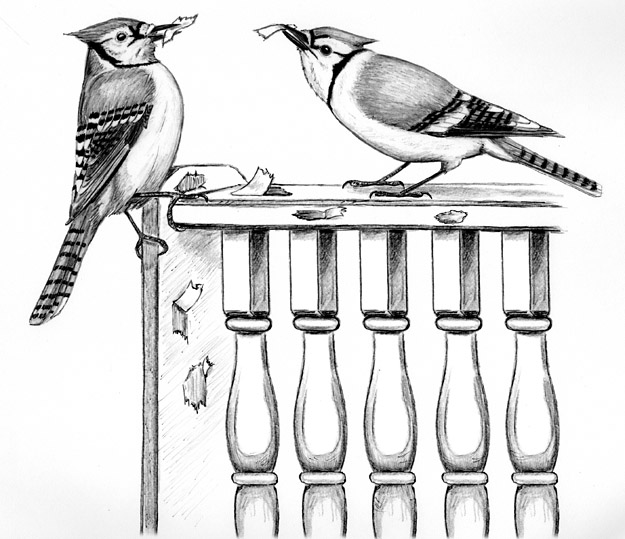
Dear Bird Folks,
This might be the strangest question you’ve ever had. In the past week Blue Jays have been coming to my deck, pounding on the railing with their beaks, peeling off chips of paint and eating them! Do you have any idea why?
– Nina, Brewster, MA
Not even close,
Nina, You might think paint-eating Blue Jays would be high on my list of strange questions, but it doesn’t even make the top ten. Don’t forget, in the summer we see a lot of people from New Jersey. Last year a guy from Paterson wanted to know where he could see a “new thatch.” What? He repeated himself and then gave me a look that suggested I didn’t know very much about birds. I handed him a bird book and told him to point out a “new thatch.” He immediately opened the book and showed me the bird he was talking about. It was a picture of a White-breasted Nuthatch, which is apparently pronounced “nu thatch” in Paterson. I informed the guy that the best place to see a new thatch is in “Providence Town.” The guy smiled, turned around and left, in search of Providence Town with visions of new thatches dancing in his head. Fortunately for me, I haven’t seen the guy since.
After receiving your note I started wondering what makes paint so delicious and why so many things want to eat it. Kids like to eat paint so much that the manufacturers now have to make it without adding lead. (Because we all know that paint is perfectly fine to eat as long as it’s lead-free.) Dogs seem to like it, too. Painted doorjambs are one of their favorite things to chew on. And now, according to you, Blue Jays are also dining on paint. To find out what this paint-eating craze is all about I went into my local Sherwin-Williams store and the answer was right there on the paint charts. The names of many of the paints are so yummy-sounding I was tempted to take a bite myself. Here are a few flavors…I mean colors…of paints that I found, and I swear I’m not making a single one up. There is French roast, Black Bean, Fabulous Grape, Blue Chip, Saffron Thread, Wild Current, Malted Milk and Sunflower, which I suspect is the jays’ favorite. However, the color that put a smile on my face is a nonfood sounding paint simply called “Reddish.” That’s right, just Reddish. The Sherwin-Williams paint namers were clearly in a hurry to get home the day they came up with that one.
Even though paint-eating Blue Jays are rare, they’re not unheard of, either. A few years ago the eggheads at Cornell’s Lab of Ornithology wrote a story about this very same topic. It turns out that some types of paint contain limestone. How about that? (And all this time I thought paint was made by mixing saffron threads, wild currants and malted milk.) The jays ingest the limestone-laced paint because limestone is a good source of calcium. The more calcium they eat, the less likely they are to break a hip, plus they won’t have to blow all of their cash buying Boniva from Sally Fields. In addition to hip health, the females need increased amounts of calcium to help with their egg production during the spring’s breeding season. I know what you are thinking. It’s only February and spring is a long way off, regardless of what Punxsutawney Phil says. Why eat the paint now? One theory is that the birds grab the calcium when they can find it and stash it for later, the same way they cache extra food. Normally the birds obtain enough calcium through their diet and the grit they pick up from the ground. But some years, such as this one, the ground is covered by snow and ice, so the birds have to switch to plan B, which means eating mouth-watering paint.
One way we can help the Blue Jays, and save our decks and homes from being stripped clean, is to provide the birds with some calcium. How do we do that? The best way is to put out eggshells. While feeding one bird the eggshells of another bird’s babies may be a moral dilemma for some of us, jays being jays have no problem with it. Here’s what to do. After you’ve made your famous rhubarb quiche, take the empty shells, place them on a cookie sheet and pop them into the oven. Set the oven at 250 degrees and bake the shells for twenty minutes, or until the edges of the eggs turn brown. This process kills any bacteria and also gets rid of all that gross, juicy stuff. Finally, crush the shells into small pieces and place the pieces on a board, or a plastic plate or your grandmother’s sterling silver crushed eggshell platter. Put the shells outside and the birds will take it from there.
Paint-eating Blue Jays seem to be most common in New England, Nina. A possible reason for this is that the calcium in our soil has been depleted by acid rain (remember that?). No one knows why this behavior is confined to just Blue Jays, though, since all birds need calcium. With that last sentence in mind, putting out crushed eggshells is not a bad idea. Many species of birds will be happy to take them, particularly when they are nesting. Heck, if you are lucky you may even attract a few White-breasted New Thatches, especially if you are from Paterson, NJ or Providence Town, whatever state that’s in.